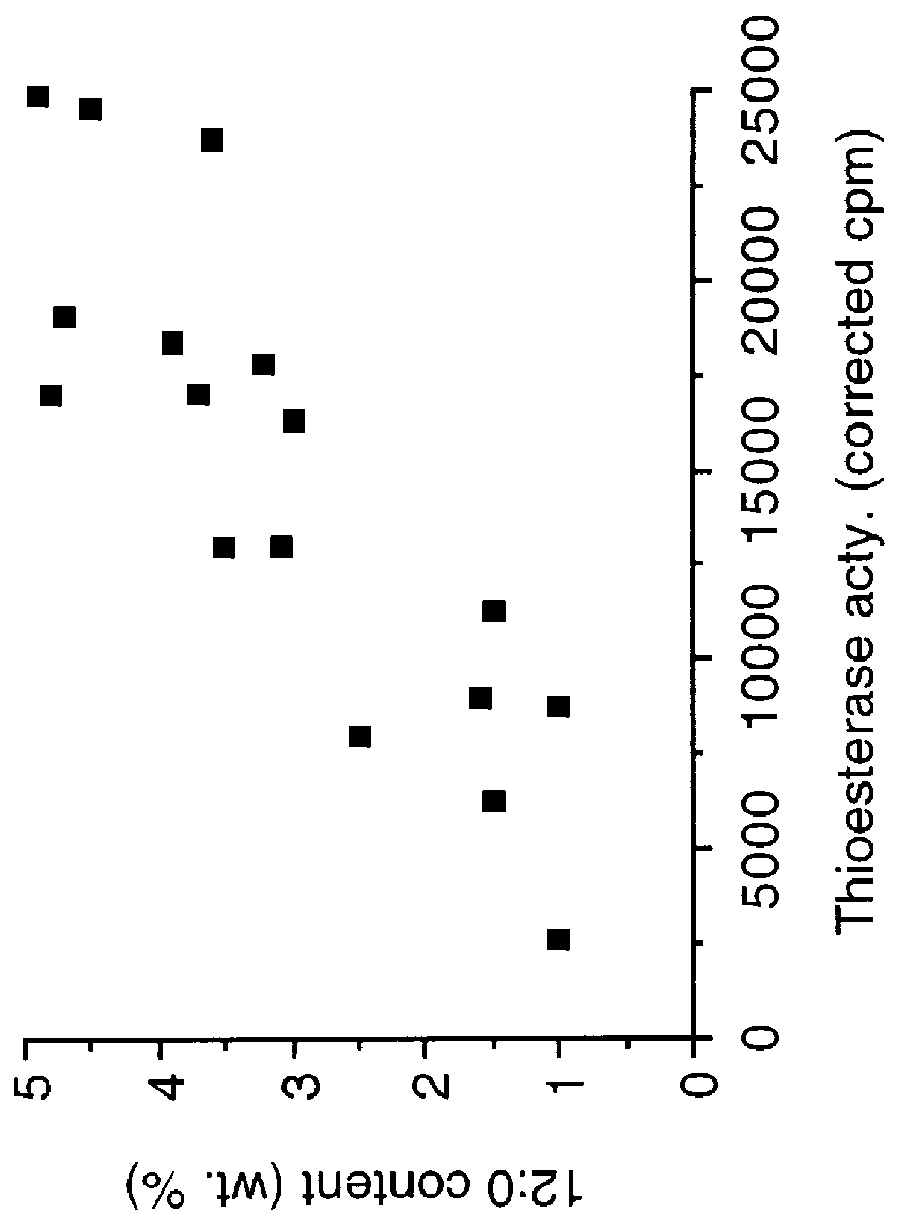Plant C18:1 preferring thioesterases
a technology of plant c18 and thioesterase, which is applied in the field of plant c18 : 1 preferring thioesterase, can solve the problems of not knowing the amino acid sequence and corresponding nucleic acid sequence of many of the proteins responsible for this activity
- Summary
- Abstract
- Description
- Claims
- Application Information
AI Technical Summary
Problems solved by technology
Method used
Image
Examples
example 1
C12-Preferring Acyl-ACP Thioesterase Assay
To assay for C12 thioesterase activity the following mixture is incubated at 30.degree. for 30 min: "buffer" comprising 7 mM KH.sub.2 PO.sub.4 -KOH pH 8, 20% v / v glycerol, 1 mM dithiothreitol (DTT), 0.1% v / v Triton X100; sample to be tested for activity in the same or similar buffer as the "extraction buffer" described in Example 2; and 5 .mu.l of .sup.14 C-radiolabeled lauroyl-ACP substrate for a total volume of 100 .mu.l and final lauroyl-ACP concentration of 0.5 .mu.M. Lauroyl-ACP substrate is prepared according to the method of Rock et al (Methods in Enzymology (1981) 72:397-403), using ACP prepared from Escherichia coli by the method of Rock and Cronan (Methods in Enzymology (1981) 71:341-351). The laurate is radiolabeled in the carboxylate group at a specific radioactivity of 50-60 Ci / .mu.mol.
The reaction is stopped by adding 0.5 ml cold (0.degree.) 10% v / v acetic acid. The fatty acid product of the hydrolytic enzyme action is extracte...
example 2
Bay Thioesterase Purification & Identification
Immature seeds of Umbellularia californica ("Bay") are harvested at the stage at which decanoate and laurate predominate in the fatty acid composition as determined by total fatty acid analysis of the cotyledons. The cotyledons from such seeds are dissected from the other seed parts and stored frozen at -70.degree.. This comprises the source tissue for enzyme extraction.
The frozen cotyledons are powdered in a stainless steel mortar and pestle at approximately -70.degree., and the powder is stored under liquid nitrogen or at -70.degree. until required. Extraction is accomplished by adding, at 0-4.degree., to the powder 4 ml / g of "extraction buffer" comprising 50 mM KH.sub.2 PO.sub.4 -KOH pH 6.9, 5 mM ethylenediamine tetraacetate (EDTA), 2 mM DTT, 1 mM sodium ascorbate, 1 mM phenylmethylsulfonyl fluoride, 1 .mu.M leupeptin, and 1 .mu.M pepstatin. The stirred mixture of powder and buffer is blended in a motorized macerator (Brinkmann (Westb...
example 3
C12-preferring acyl-ACP Thioesterase Inhibitor Studies
Table 1 below reports inhibition of Bay cotyledon C12-preferring acyl-ACP thioesterase by thiol reagents observed when an ammonium sulfate fraction (see, Example 2) was assayed (see, Example 1).
After removal of dithiothreitol from an ammonium sulfate fraction preparation by passage through a small column of G25-50 gel filtration medium (Pharmacia, Piscataway, N.J.) the following assay results were observed.
These preliminary inhibitor studies indicate that the Bay C12-preferring acyl-ACP thioesterase is insensitive to 5 mM iodoacetamide and almost completely inhibited by 5 mM N-ethylmaleimide. These results suggest that C12-preferring acyl-ACP thioesterase is an "active thiol" type of esterase rather than an "active serine" type.
PUM
| Property | Measurement | Unit |
|---|---|---|
| Temperature | aaaaa | aaaaa |
| Temperature | aaaaa | aaaaa |
| Temperature | aaaaa | aaaaa |
Abstract
Description
Claims
Application Information
 Login to View More
Login to View More - R&D
- Intellectual Property
- Life Sciences
- Materials
- Tech Scout
- Unparalleled Data Quality
- Higher Quality Content
- 60% Fewer Hallucinations
Browse by: Latest US Patents, China's latest patents, Technical Efficacy Thesaurus, Application Domain, Technology Topic, Popular Technical Reports.
© 2025 PatSnap. All rights reserved.Legal|Privacy policy|Modern Slavery Act Transparency Statement|Sitemap|About US| Contact US: help@patsnap.com



